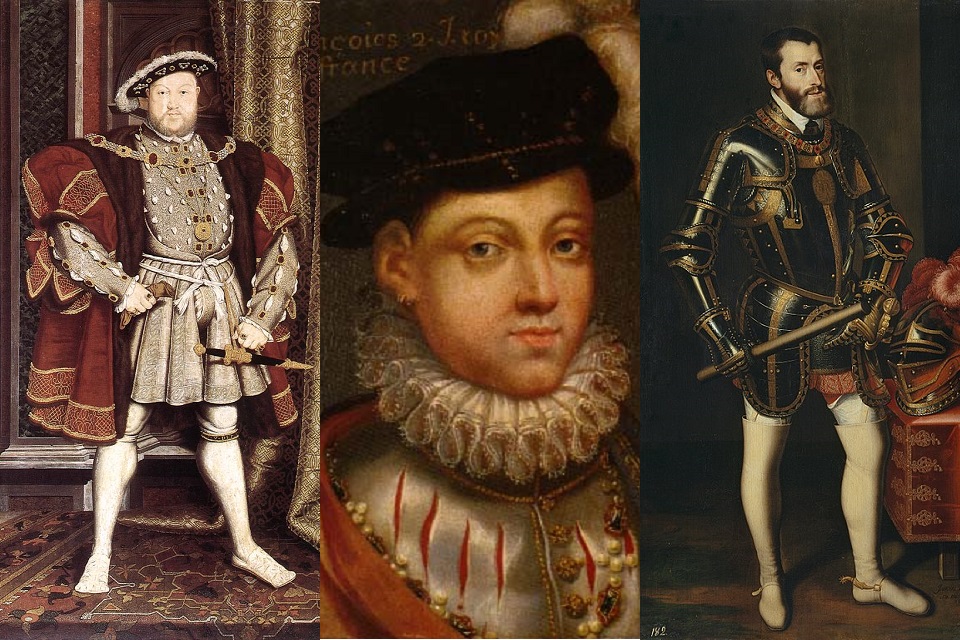Fashion in the period 1500–1550 in Western Europe is marked by voluminous clothing worn in an abundance of layers (one reaction to the cooling temperatures of the Little Ice Age, especially in Northern Europe and the British Isles). Contrasting fabrics, slashes, embroidery, applied trims, and other forms of surface ornamentation became prominent. The tall, narrow lines of the late Medieval period were replaced with a wide silhouette, conical for women with breadth at the hips. Sleeves were a center of attention, and were puffed, slashed, cuffed, and turned back to reveal contrasting linings.
At the beginning of this period, the silhouette of the men was long and narrow, but gradually it widened until the reign of Henry VIII, the silhouette was almost square, with large sleeves. Throughout this period, fashionable men’s clothing consisted of:
a shirt linen, originally without a neckline, but with a larger neckline in the middle of the century. The neckline was created in a narrow band and adjusted by means of a cord, the small flying formed by pulling the cord widens over time.
a jacket, usually cut at the waist and skirts at the knee.
Academics, magistrates, doctors and other professionals have not kept the dress down to the ankle throughout the period. In the 1530s, a narrower silhouette became popular under the Spanish influence. The skirts are shorter and slightly flared. Overall, the method was more rigid and sober 7 . Men of the lower classes wore a one-piece garment called cotte in English. Bright colors (red, yellow, purple, pink and green) were very popular.
The 16th century, the age of the Renaissance and the Reformation and time of spiritual change, also brought a transformation in the costume. The costume was no longer intended to wrap the body tightly, but to allow for a comfortable movement and to appear free and dignified at the same time as the earlier time.
Regional variations in fashionable clothing that arose in the 15th century became more pronounced in the sixteenth. In particular, the clothing of the Low Countries, German states, and Scandinavia developed in a different direction than that of England, France, and Italy, although all acknowledged the sobering and formal influence of Spanish dress after the mid-1520s.
Men’s fashion
Overview
Early in this period, men’s silhouette was long and narrow, but gradually it grew wider until by the later reign of Henry the VIII the silhouette was almost square, with shoulder emphasis achieved through wide revers and collars and large sleeves.
Throughout this period, fashionable men’s clothing consisted of:
A linen shirt or chemise, originally low-necked but with a higher neckline by mid-century. The neckline was gathered into a narrow band or adjusted by means of a drawstring; the tiny ruffle formed by pulling up the drawstring became wider over time, and then evolved into the ruff of the next period.
A doublet with matching sleeves, often slashed or cut to allow the fabric of the shirt beneath to show through.
A jerkin, usually cut low to the waist in front to reveal the doublet beneath, with full skirts to the knee.
Hose, now usually ending above the knee, with a prominent codpiece (both sometimes hidden under the skirts of the jerkin).
Separate nether-hose or stockings held up with garters.
A front-opening overgown, often fur-lined for warmth and slashed, with sleeves. The overgown was ankle length early in the period, but knee-length overgowns were fashionable in the 1530s and 1540s. Scholars, judges, doctors, and other professionals retained the ankle length gown throughout the period.
From the 1530s, a narrower silhouette became popular under Spanish influence. Collars were higher and tighter. Shoulders lost their padding and developed a slight slope. Doublet sleeves became fuller rather than tight. Jerkins closed to the neck; their skirts were shorter and slightly flared rather than full, and they displayed more of the hose. Overall the fashion was more rigid and restrained.
Lower class men wore a one-piece garment called a cotte in English, tight to the waist with knee-length skirts and long sleeves over their hose.
Bright colors (reds, yellows, purples, pinks, and greens) were popular.
Matthäus Schwarz compiled a Klaidungsbüchlein or Trachtenbuch (usually translated as “Book of Clothes”), a book cataloguing the clothing that he wore between 1520 and 1560. The book contains color illustrations focused on Schwarz’s individual clothing history.
Hairstyles and headgear
A variety of hats were worn in the period. The German ‘barett, with its turned-up brim, was fashionable throughout the period, and a similar hat with a turned-up round or “halo” brim was popular in the court of Henry VIII. The flat hat combined a low, gathered crown with a circular brim and was worn in mid-century.
Style gallery 1500–1510
 1 – c. 1500 |
 2 – c. 1500 |
 3 – 1500–1510 |
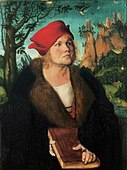 4 – 1502–03 |
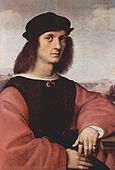 5 – 1506 |
|---|---|---|---|---|
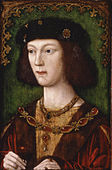 6 – 1509 |
1.Arthur, Prince of Wales wears a red hat with two gold buttons and a badge. He wears a jewelled collar of knots and Tudor roses over a reddish overgown with dark fur trim, c. 1500.
2.Henry VII wears a red-and-gold brocade overgown over another fur garment. He wears the collar of the Order of the Golden Fleece, c. 1500.
3.Italian hose of the first decade of the century. The man on the left wears hose divided into upper hose and nether hose or stockings. The man on right wears hose slashed around one thigh, with a pouched codpiece, 1500–1510.
4.Johannes Cuspinian wears a fur-lined brocade overgown over a front-laced red doublet and a low-necked shirt or chemise. He wears a red hat with an upturned brim, 1502–03.
5.Angelo Doni wears Italian fashion: a dark doublet with pink sleeves, loose hair, and a hat with a turned-up brim, 1506.
6.The young Henry VIII’s hair is worn chin length. His overgown has wide revers and is worn with a jeweled collar, 1509.
Style gallery 1510s
 1 – 1510 |
 2 – 1512 |
 3 – 1512-15 |
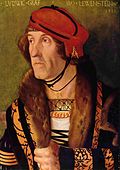 4 – 1513 |
 5 – 1514 |
|---|---|---|---|---|
 6 – 1519 |
 7 – 1519 |
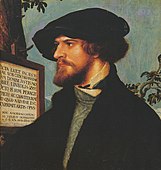 8 – 1519 |
1.Italian youth wears striped hose, a doublet with puffed upper sleeves, and a voluminous cloak, 1510.
2.The Swiss Guard at the Vatican wear full-skirted giornea or jerkins and full sleeves over low-necked shirts or chemises, 1512.
3.Unknown man wears a doublet with slashed sleeves and an overgown with a gray fur collar.
4.Ludwig, Count von Löwenstein wears a fur-lined overgown in the German fashion and a red barett with a jewel in the form of a pair of compasses, 1513.
5.German fashion includes a multitude of slashes in rows on doublet, hose and overgown, 1514.
6.The Emperor Maximilian I, in his portrait by Dürer, wears an overgown with a very wide fur collar and a broad-brimmed hat, 1519.
7.Georg Zelle wears a brocade overgown with a fur lining and slashed sleeves. The neck of his shirt is open, 1519.
8.Bonifazius Amerbach wears a high-necked shirt and a high-necked doublet under a dark overgown. His hat is rounded and soft, rather than angular, 1519.
Style gallery 1520–1535
 1 – 1520–25 |
 2 – 1521 |
 3 – 1525 |
 4 – 1527 |
 5 – 1532–33 |
|---|---|---|---|---|
 6 – 1533 |
 7 – 1534–35 |
 8 – c. 1535 |
1.Francis I of France wears a wide-necked doublet with paned sleeves under dark gold jerkin and a satin overgown with turned-back sleeves. His shirt has a tiny frill edged in black at the neck and wide ruffles at the wrist. Jean Clouet, c. 1520–25.
2.Lucas Cranach the Elder’s Young Man wears the later style of barett, wide and flat with a slashed brim. His high neckline is accented by parallel rows of slashes, and he wears a brown overgown, 1521.
3.Federico II Gonzaga wears a doublet with full skirts to mide thigh, soft “loops” at the shoulder, and gold embroidered bands at the border over bright red hose and a prominent codpiece, Italy, 1525,
4.Sir Henry Guildford wears a wide necked brocade doublet, a jerkin, and a fur-lined overgown. His wide-necked shirt is bare visible under his doublet the left shoulder. 1527.
5.Emperor Charles V wears slashed hose and sleeves in the German fashion. His overgown has puffed upper sleeves and a black (probably fur) lining. His shoes have squarish toes and reach high over his instep, 1532–33.
6.Jean de Dinteville, French ambassador to England, wears a fur-lined calf-length overgown over a black jerkin and a slashed doublet of rose-colored silk. His shoes are very square at the toes, 1533.
7.Charles de Solier, Sieur de Morette wears a high-necked doublet under darker jerkin and an overgown. His sleeves are paned (made in strips) and fastened with jewels. The square beard was very popular with the broad silhouette of 1534–5.
8.Holbein’s Man with a Lute wears a transitional costume—a wide-necked doublet with a high, banded-neckline shirt, c. 1535.
Style gallery 1535–1550
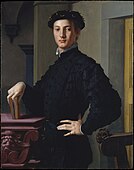 1 – 1535–40 |
 2 – 1539–40 |
 3 – c. 1540–42 |
 4 – 1541 |
 5 – 1542 |
|---|---|---|---|---|
 6 – 1544 |
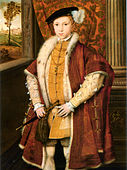 7 – 1546 |
 8 – 1548 |
1.Bronzino’s Young Man with a Book wears a dark slashed doublet with a standing collar and matching hose. His shirt has a small ruffle at the neck, and his hat is decorated with pairs of metal tags or aiglettes. Florence, 1535–40.
2.Thomas Howard, 3rd Duke of Norfolk wears a black overgown lined with lynx fur over a jerkin lined in a brown fur and a reddish doublet. His shirt has an embroidered standing collar. He wears a black “halo” hat over a black coif, and the collar of the Order of the Garter, 1539–40.
3.Count Sciarra Martinengo Cesaresco wears an overgown lined in lynx over a blue doublet with quilted sleeves. His hat badge is inscribed in Greek “Alas! yearn exceedingly”.
4.Unknown man in a modest costume of 1541. He wears a brown satin doublet with full, unslashed “round” sleeves under a dark overgown. His shirt has a standing band with embroidery and a ruffle.
5.Henry VIII in 1542 wears a closed red ermine-lined overgown with narrower shoulders and a high collar.
6.Seated youth wears a pinked and slashed leather jerkin and a black sword belt and hanger over a red doublet and red hose with a prominent codpiece. Germany, 1544.
7.Edward VI wears the leaner, narrow fashions of 1546. The shoulders are no longer wide, and the jerkin’s skirts are flared but not gathered, and are shorter than the hose.
8.Emperor Charles V wears a black, fur-lined overgown over a black doublet, hose, stockings and shoes. His shoes have slightly rounded rather than square toes, 1548.
Source from Wikipedia
